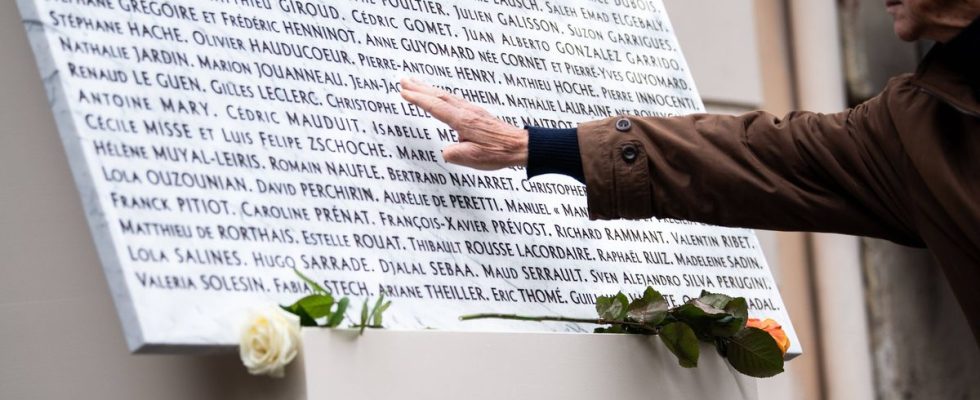Eight years already… On November 13, 2015, three jihadist commandos sowed terror in Saint-Denis, near the Stade de France, and in Paris, leaving 130 dead and more than 350 injured. In the Bataclan concert hall, 90 people lost their lives during terrorist attacks claimed by Daesh. Every year, commemorations take place in front of the scene of the tragedy in memory of the victims. Press photographers are present to cover the event, trying to find the right distance between respect for contemplation and the desire to capture the emotion of the moment. The photojournalist Jeanne Accorsinifrom the agency Sipa Pressexplains to 20 minutes the making of a photo taken during the ceremony in front of the Bataclan on November 13, 2023.
What do we see in the image?
“We see an elderly man approaching the stele where the names of the deceased are inscribed. He comes to touch the name of a person precisely with his hand, details it 20 minutes Jeanne Accorsini. Without wanting to overinterpret by not knowing the identity of this man, I imagine that he is a relative of one of the victims, a father or grandfather. » Indeed, the man in the image is of a different generation than that seen at the Bataclan. During this moment of contemplation, we observe that the point, the clear part of the image, is on the hand and some names. “It’s really this impulse towards the stele, this symbolic gesture, that I wanted to highlight,” adds the photographer. The atmosphere was very silent, it was a special, calm moment. I took the photo because I was touched by this gesture. »
What is the shooting context?
“This photo was taken just after the Prime Minister, Élisabeth Borne, and the politicians came for the ceremony in tribute to the victims of the Bataclan attack during the attacks of November 13, 2015. Just after the politicians left, families and passers-by were able to approach the stele to reflect and place flowers,” continues the photojournalist. She confides that she didn’t want to highlight the faces too much. “As a photographer, my concern was really to find the right distance from the subject to respect and not disturb the intimacy of the moment, while still being a witness and showing what is happening. » All this while managing your own emotions by returning to a place that evokes special memories for everyone. Even more so for those who already lived in Paris eight years ago.
The extra anecdote
By evoking the management of emotion that this type of event can arouse, Jeanne Accorsini delivers a more personal memory. “I am a photographer but in 2015, I am also a person who had only been living in Paris for a few months during the November 13 attacks. This affected me a lot even though I was at home safe. There was a lot of anxiety around me. The one I had compared to my friends who were outside that evening. I had to go out to République too. Then there was the anguish of my parents, my loved ones, who asked me if I was safe and secure, and I cowered a little. And even there at home, I didn’t feel safe. »
It’s true that every person can remember exactly what they were doing that evening, who they were with and how they felt. And returning to the scene in a moment of contemplation can reactivate certain emotions. “When I arrived there, my hands were shaking a little,” confides the journalist. I wasn’t very comfortable but I said to myself: “Take charge Jeanne, take the camera and go take photos!” » If indeed it was not easy to return to the Bataclan in this atmosphere, she adds that she has “the duty to inform” by putting herself in “a kind of bubble” where she concentrates on her work of taking pictures. “When I hold my case in my hands, I think of my frame, my intention. And when I see an image, I tell myself that the emotions I feel through my lens must come out in the photo. » All the difficulty of finding the right distance so as not to let yourself be overwhelmed by emotion and respect the subject, without being too neutral.

